The accelerated evolution of the IT industry has created an insatiable appetite for software developers with the skills and expertise to deliver innovative products. Businesses are increasingly turning to outsourcing companies to meet demand.
For a long time, outsourcing was limited to offshore vs onshore development. The advantage of onshore outsourcing is time zone similarity, which boosts collaboration. However, it is the costliest option. Offshore outsourcing is the opposite. It is the cheapest option, but time zone differences create communication barriers.
Enter nearshore outsourcing, which maximizes the advantages of the other two while minimizing their disadvantages.
This article explores the features, services, and offerings of the top nearshore outsourcing companies to help you choose the right outsourcing partner for your business.
Top nearshore IT outsourcing companies
We’ve compiled a list of the best nearshore outsourcing companies to help you navigate the complexity of selecting the right partner. Each company has its strengths and unique approach to service delivery.
Our criteria include companies with a minimum of five years in the market and a Clutch rating of 4.8 and above. We’ve compared them along with the services provided, tech stack, and outsourcing style to help you make a strategic match.
1. Miquido
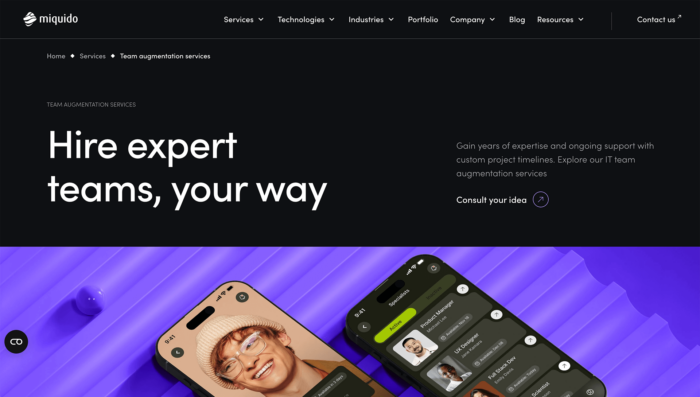
Average Rating: 4.9
Location: Krakow, Poland
If you’re a European company looking for IT experts closer to home, then nearshore software outsourcing in Poland is your best bet. A growing tech talent pool, language proficiency, and universal cultural fit have helped establish the country as a leading software hub.
That’s where you’ll find Miquido, an award-winning and Google-certified development company with over 13 years of experience. And yes, that’s our company! We provide nearshore software development outsourcing for the retail, fintech, and entertainment industries.
You can scale your development capacity with a 200-plus team of developers, IT architects, UX/UI designers, project managers, quality assurance engineers, and AI consultants.
Our core services are:
- Custom software development
- Web app development
- Mobile app development
- Product strategy
- UX/UI design
- UX audits
Tech competencies include:
- AI – chatbots, conversation AI, generative AI, natural language processing, machine learning, AI recommendation systems.
- Application platforms – Amazon, Google
- Frameworks – React, Angular, VueJS, React Native, NodeJs
- Mobile platforms – Android, iOS, Flutter
- Programming – JavaScript, Go, Java, Kotlin
Outsourcing model:
- Staff augmentation: we supplement and scale your workforce with various IT experts
- Dedicated teams: we provide a multidisciplinary team of experts to manage entire projects
Clients include Dolby, Abbey Road Studios, Warner Recorded Music, Nextbank, and Herbalife
2. Root Stack
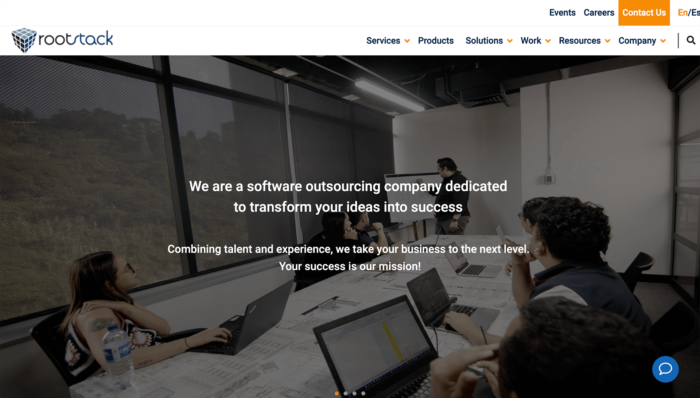
Average rating: 4.8
Location: Texas, USA
Root Stack is a software development company from Austin, Texas. They have over 14 years of experience and offer onshore and nearshore outsourcing for clients in the US, Canada, and Latin America.
They serve the automotive, banking, education, entertainment, and food industries. The team of developers, UX/UI designers, and QA engineers can help you build and maintain your software.
Core services are:
- Custom software development
- Web app development
- Mobile development
- AI development
- Big data consultation
Tech competencies include:
- Application platforms – Amazon, Azure, Linux, Windows
- Frameworks – Drupal, Angular, React, .Net
- Mobile platforms – Android, iOS, Flutter
- Programming – ASP.NET, JavaScript, PHP, AJAX, C#, Ruby
Outsourcing approach:
- Staff augmentation: provide developers for your projects
- Managed teams: manages entire product development
- Managed services: manages infrastructure maintenance, security, and cloud computing
Clients include LG, Bayer CAT, Hyundai, and Heineken.
3. Loop Studio
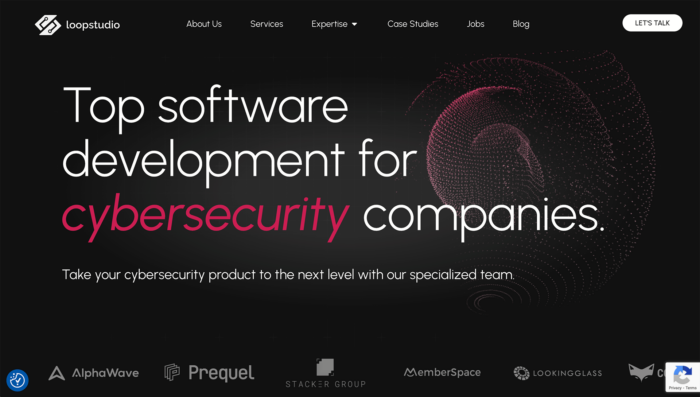
Average rating: 5.0
Location: Montevideo, Uruguay
Loop Studio is an app development company from Uruguay that specializes in cybersecurity.
They serve clients in four time zones (EST, CST, MST, PST), offering nearshore software development services like product design, MVP development, prototype services, and staff outsourcing. These include project managers, UX/UI designers, software developers, data engineers, and QA experts.
Industries that benefit from their services include healthcare, analytics, finance, and construction.
Core services are:
- Custom software development
- AI development
- Web app development
- Product design
- UX/UI design
Tech competencies include:
- AI – chatbots, conversational AI, recommendation systems, machine learning, voice & speech recognition
- Application platforms – Amazon, Google, Heroku
- Frameworks – React, React Native, Ruby on Rails
- Programming – JavaScript, Ruby, Typescript
Outsourcing approach:
- Staff augmentation: supplement your long or short-term projects with various IT roles
- Dedicated teams: manage the entire software development lifecycle or IT functions
Clients include Looking Glass, Alpha Wave, Blue Cloak, and Trapezoid
4. NeoCoast
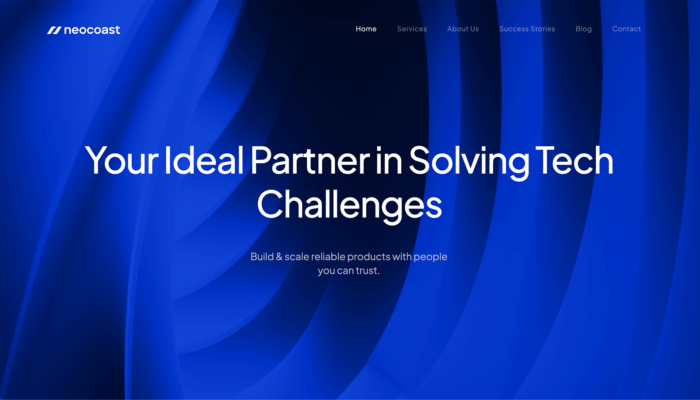
Average rating: 5.0
Location: Montevideo, Uruguay
NeoCoast is a nearshore software development company serving clients in the US. They offer customer software solutions for the education, healthcare, and eCommerce industries.
The dedicated teams of project managers, UX/UI designers, software developers, and QA engineers develop high-quality web and mobile applications.
Core services are:
- Product Discovery
- Customer software development
- Web app development
- Mobile app development
- MVP development
- UX/UI design
- Test and quality assurance
- Project management
Tech competencies include:
- Application platforms – Amazon, Heroku
- Frameworks – React, Ruby on Rails, NodeJS, React Native, VueJS
- Mobile platforms – cross-platform development
- Programming – JavaScript, Ruby, Redux
Outsourcing approach:
- Dedicated teams: a multidisciplinary team of experts to manage entire projects
Clients include ThinkCERCA, Frootbat, Nuro Retention, and Food Connect.
5. Morean
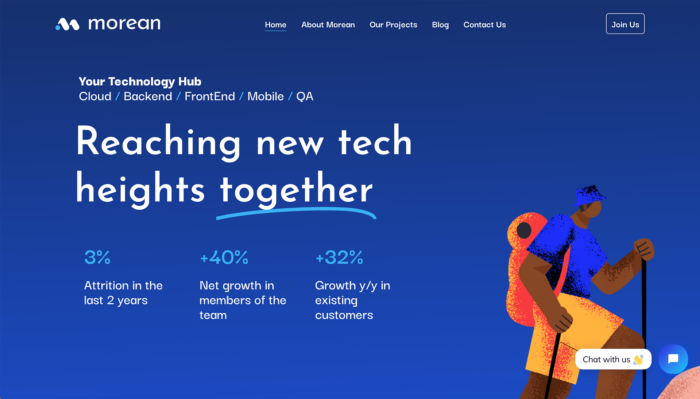
Average rating: 4.8
Location: Florida, USA
Morean is a US-based software firm that offers tailored software solutions and IT outsourcing for US and Latin American clients. The team of developers and quality assurance engineers can augment your existing internal team or manage entire projects.
They serve clients in the logistics, food, and finance industries.
Core services are:
- Custom software development
- IT outsourcing
Tech competencies include:
- Application platforms – Amazon, Azure, Google
- Frameworks – Angular, NextJS, NodeJS, React Native, Ruby on Rails, React, VueJS
- Programming – Java, Ruby, JavaScript, Typescript, Kotlin, C#, Go
Outsourcing approach:
- Staff augmentation: augment your team with developers and QA engineers
Clients include Truckbase, Fletti, Plus, and Delivery Hero.
6. FCamara
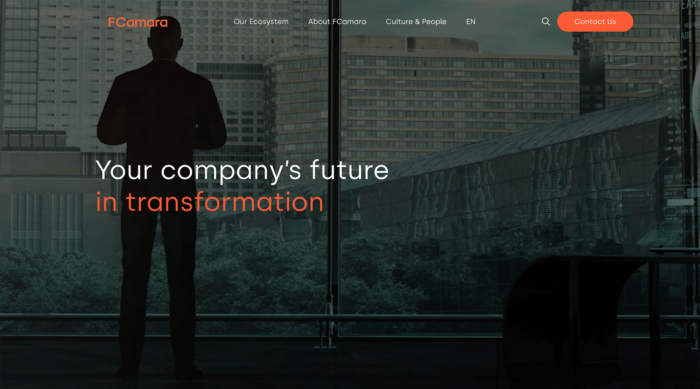
Average rating: 4.7
Location: Sao Paulo, Brazil
FCamara is a Brazilian multinational technology and innovation ecosystem. The company has over 17 years of experience and a proprietary framework.
With offices in Europe and the Middle East, they service seven time zones and three regions. They offer digital consultation, product design, infrastructure management, and software development to the retail, healthcare, and finance industries.
Core services are:
- API development
- Cloud consulting services
- Customer software development
- eCommerce development
- Enterprise app modernization
- Strategy consultation
- Low/No development
- Mobile app development
- UX/UI design
Tech competencies include:
- Application platforms – Azure, Amazon, Linux, Windows
- eCommerce Systems – Magento, SAP eCommerce
- Frameworks – Adobe Experience Manager, Microsoft SharePoint, WordPress CMS
- Mobile platforms – Android, IOS,
- Programming – C#, Java, JavaScript, PHP, Python, Ruby, SQL, Swift, Typescript
Outsourcing approach:
- Staff augmentation: integrate developers into your team
- Managed teams: development teams work with your project manager and priorities
- Squad: fully managed IT projects and functions
Clients include Coca-Cola, Nestle, Johnson and Johnson, Ipsos, and Carrefour.
7. Clarika
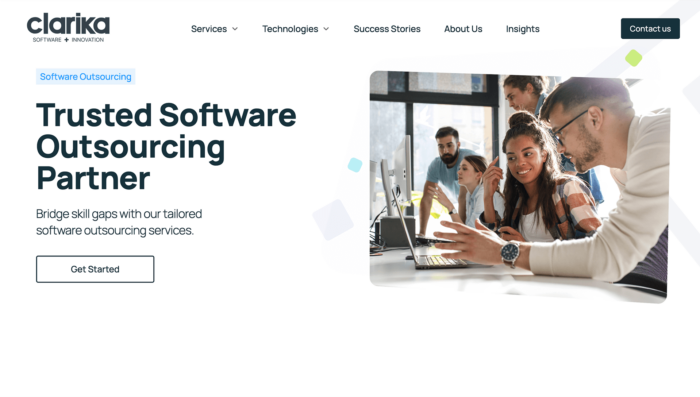
Average rating: 4.9
Location: Cordoba, Argentina
Clarika is a nearshore software development company servicing clients in the US, Canada, Latin America, and Europe. The IT developer specializes in creating, testing, and launching custom software for the food, medical, construction, and manufacturing industries.
This Argentinian company has 17 years of experience and a pool of managers, developers, designers, data scientists, and business analysts.
Core services are:
- Custom software development
- AI development
- Enterprise app modernization
- Mobile app development
- Web app development
Tech competencies include:
- Application platforms – Azure, Windows, Google, Linux, Amazon.
- Frameworks – .NET, Flutter, WordPress CMS, Angular React Native NodeJS
- Mobile platforms – Android, IOS, cross-platform
- Programming – C#, ASP.NET, JavaScript, Kotlin, PHP, Redux, SQL, Go, Objective C, Python, Swift
Outsourcing approach:
- Staff augmentation: covers internal skills gaps with various IT roles to boost productivity
- Dedicated teams: a multidisciplinary team of experts to manage entire projects
Clients include McDonalds, Saffire, Imperial, and Revi.
8. Brightscout
Average rating: 5.0
Location: Texas, USA
Brightscout is a global branding and development agency specializing in B2B tech businesses. With offices in the US, Argentina, and Serbia, the company serves clients in North America, Latin America, and Europe.
The team consists of brand designers, copywriters, software developers, and 3D and visual designers.
Core services are:
- Branding
- Custom software development
- Low/No code development
- Mobile app development
- UX/UI design
- Web development
- Web design
Tech competencies include:
- Application platforms – Amazon, Azure, Linus, Google
- Frameworks – React, React Native, Angular, Flutter, GatsbyJS, Netlify
- Programming – JavaScript, Go, Swift, Java, Kotlin, PHP, Python, Ruby, SQL
Outsourcing approach:
- Staff augmentation: for short-term, ad-hoc projects and tasks
- Dedicated team: for long-term or continuous design and development
Clients include Gable, Tallywell, Meltano, and Phylum.
9. Leanware
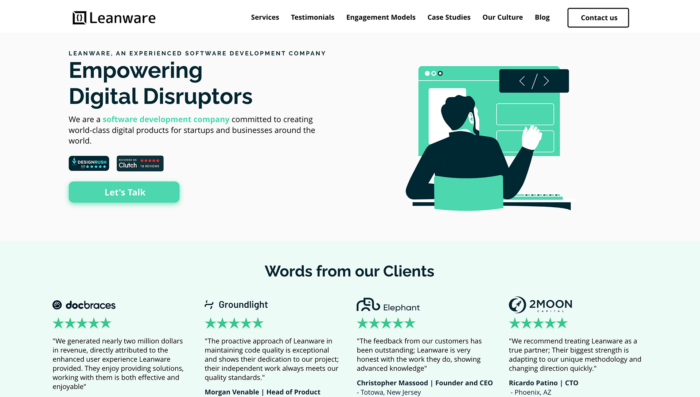
Average rating: 4.9
Location: Bogota, Colombia
Leanware is a Colombian software development company creating mobile and web applications for US clients. Industries they develop for and outsource include finance, education, and healthcare.
Core services are:
- AI consultation
- Customer software development
- Mobile app development
- Web development
- Low/No code development
- UX/UI design
Tech competencies include:
- AI – recommendation systems, cognitive computing, machine learning, natural language processing
- Application platforms – Azure, Google
- Frameworks – React, React Native, Angular, Django, Flutter, Gatsby JS, NextJS, Node JS
- Mobile platforms – Android, iOS, cross-platform
- Programming – HTML, JavaScript, Python, Redux, SQL, Typescript
Outsourcing approach:
- Staff augmentation: bridge skills gaps in your internal team
- Managed team: a multidisciplinary team of experts integrates with your processes and systems
Clients include 2 Moon Capita, Elephant CPA, Kairos, and Enovis.
10. Simform
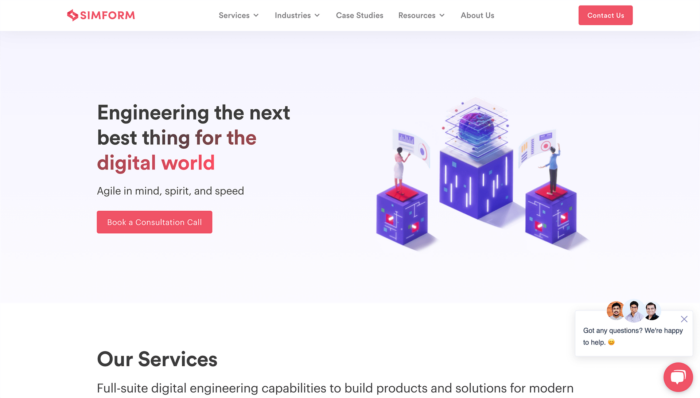
Average rating: 4.8
Location: Orlando, Florida
Simform is a digital engineering firm created by engineers for engineers. The company has 14 years of experience and serves clients in the US, Canada, India, and Dubai. The team of 1300 experts creates scalable products for SMEs and enterprises in the retail, healthcare, supply chain, and fintech industries.
Core services are:
- Product and platform engineering
- Cloud Engineering
- DevOps engineering
- Data Engineering
- AI/ML engineering
- Digital experience engineering
Tech competencies include:
- AI – chatbots, conversation AI, machine learning, AI recommendation systems, natural language processing, voice & speech recognition
- Application platforms – Amazon, Azure, Linux, Google, Window
- Cloud computing – AWS, Azure, Google
- Frameworks – .NET, Angular, Django, Node JS, React, Flutter
- Mobile platforms – Android, iOS, cross-platform
- Programming – ASP.NET, C#, Java, JavaScript, PHP, Python, Ruby, SQL, Swift
Outsourcing approach:
- Managed teams: teams of developers integrate with your processes and systems.
Clients include Redbull, Fuji Film, Cisco, Hilton, and Bank of America.
Factors to consider when picking a nearshore outsourcing company
You’re not alone when you choose to outsource IT operations. 92% of the top 50 companies use this strategy to increase capacity, boost efficiency, and reduce costs. But these results are only possible with the right outsourcing partner.
Navigating your nearshore options requires a clear understanding of your IT needs. Therefore, you must assess your infrastructure, skills gaps, and resource availability. That will empower you to make informed decisions about which expert team augmentation services align with your business.
Here are critical factors to consider when selecting an IT service provider.
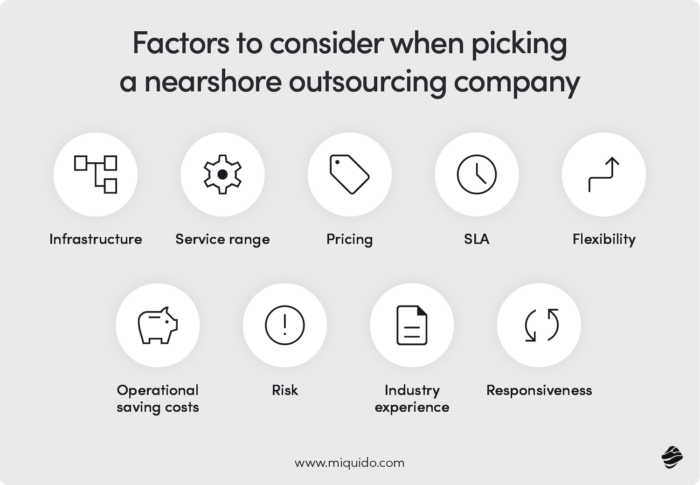
1. Infrastructure
The first thing to check is if your outsourcing provider has the infrastructure and technology to support your IT needs.
These include:
- Development programs
- Business applications
- Communication tools
- Cloud services
- Project management software
- Integration capabilities
- Security operations
Technology evolves rapidly with new software available every day. So, you want an outsourcing partner with the ability and appetite to adopt new, relevant software and hardware.
2. Operational saving costs
One of the main draws of outsourcing is operational cost savings. You should see a significant reduction in labor and asset spend. That shows you it’s cheaper to outsource than handle IT operations in-house.
However, there’s more to cost than price. Evaluating the potential return on investment tells you’re making a financially sound decision. If your outsourcing goal is to reduce the average incident resolution time from three hours to one hour, you can convert this reduction into average labor costs to see the ROI.
You should also consider service quality, productivity gains, revenue growth, and customer satisfaction. A cheap development agency will cost more in the long run if the product quality is poor and requires rework.
3. Service range
The importance of service range depends on your IT needs. If outsourcing software development, it’s better to focus on agencies with extensive bespoke software development experience. However, it is better to partner with a service provider that can address all your IT needs.
There are five IT functions top nearshore outsourcing companies offer:
- Help desk support
- Infrastructure management
- Cyber security
- Software development
- Cloud storage
Review the vendor’s case studies and history to evaluate how well they can meet your business objectives.
Evaluating the experience and expertise of potential IT support providers is crucial to ensuring they can meet your specific needs. This includes reviewing their past projects, talent pool, and company history to gauge their track record in the industry.
Choosing a service provider with a successful track record instills confidence in their ability to deliver the software outsourcing services you require.
4. Pricing
Outsourcing vendors offer various pricing structures to attract different customers and remain competitive.
Common pricing models used in nearshore outsourcing are:
- Fixed price: a predetermined cost, regardless of the time and effort used.
- Time and material: based on time and resources used.
- Hybrid: combines the fixed price and time and material models.
- Cost-plus: involves the cost of the project plus a fixed fee upon project completion.
- Retainer: fixed monthly or yearly fee for predefined services like maintenance.
Other models include performance-based and value-based pricing.
Each pricing structure has its advantages and disadvantages. The time and material model provides flexibility. However, budget overruns become common occurrences if requirements aren’t well-defined.
Fixed price contracts provide budget stability. However, they don’t allow for scope or requirements changes, which may affect app quality.
The retainer model is predictable budgeting for guaranteed service. However, you’re locked into a long-term contract.
Choose pricing models that deliver value, not just a low-price tag. That means analyzing what nearshore outsourcing services are available in various price plans. Cheap can become expensive if you don’t pay attention to hidden costs or exclusions.
5. SLA
The service level agreement (SLA) is a contract between you and your outsourcing partner that defines the service standards you expect from them.
It outlines:
- Service description – the service offered
- Service standards – the metrics that measure performance
- Remedies – the penalties for noncompliance.
The SLA protects both parties by defining expectations and responsibilities. Without it, your outsourcing contract is open to misinterpretation.
6. Risk
Outsourcing comes with risks. After all, you’re giving a third party access to sensitive information. Your outsourcing partner must have a risk management plan to mitigate data breaches and intellectual property violations.
Top nearshore outsourcing companies have robust security protocols to safeguard your business and customer data from cyber threats.
These include:
- Audit processes
- Password management
- Access management
- Data encryption protocols
- Regulatory compliance
You should also verify the provider’s plans to mitigate data loss and ensure business continuity. These should include regular backups and secure storage.
7. Industry experience
Experience and reputation are vital when choosing an outsourcing vendor. A partner with knowledge and expertise in your field will deliver relevant, high-quality products and services. They understand your industry and can suggest innovative solutions to address industry problems, propelling your business ahead of the competition.
Review prospect vendors’ portfolios and case studies to gauge their abilities and understand the industries they serve.
Reputation is as important as experience. You don’t want to be stuck in a long-term contract with an agency with a history of missed deadlines and unresponsiveness. If possible, contact previous clients to learn about their experiences. Visit review sites like Clutch or G2 for unbiased reviews.
A good track record tells you the provider is trustworthy, giving you peace of mind. You’re outsourcing because you want one less thing to worry about. Outsourcing partners shouldn’t be an added burden.
8. Responsiveness
Consistent and reliable communication is paramount to the success of outsourcing partnerships, especially for companies outsourcing entire projects and functions like technical support. Poor communication can cause delays, lower product or service quality, and damage your reputation.
Assess if the companies you’re reviewing have internal processes to support your business adequately. Ask questions about response times and availability, and ensure your SLA outlines these metrics before you sign.
9. Flexibility
The IT industry is constantly evolving, compelling businesses to adapt to emerging trends. Consequently, you need a service provider with the capacity to accommodate future needs.
For example, to assess their ability to scale project development services to your expansion plans, analyze the company size of their customer profile. Do they have medium or enterprise clients? Do they offer customizable nearshore outsourcing solutions? Do they use agile methodologies?
The ideal partner offers flexible and scalable solutions to save time and money in the long run.
Additional factors that are obvious but worth mentioning are expertise and language proficiency. The nearshore outsourcing companies you choose must have the IT specialists you need and communicate in your preferred language.
Functional difference in scaling it in-house vs outsourcing
75% of employers struggle to fill roles, with IT and data skills being the most challenging.
The tech talent shortage means businesses increasingly rely on top software development companies to compete and grow. However, the decision between outsourcing and in-house development isn’t one-dimensional.
Several deciding factors influence whether you partner with an external team or manage your IT service internally.
Cost implications
In-house: This model incurs fixed costs related to labor, IT infrastructure, overhead, and HR (i.e., recruitment, training, and development).
Outsourcing: Labor costs vary depending on project scope, work complexity, and geographic location of the service provider. However, you minimize or eliminate overhead, infrastructure, and HR-related expenses.
Access to specialized skills
In-house: You are limited to your internal team’s knowledge and skill set. If a project requires niche expertise, you must recruit and onboard the talent, which takes time and money.
Outsourcing: You have quick access to various specialists with relevant skills, knowledge, and technology to meet project requirements.
Flexibility and scalability
In-house: This model is more flexible than scalable. On one hand, you must recruit and train new members, resulting in project delays. On the other, you can quickly change project requirements to address user feedback or emerging trends.
Outsourcing: This model is more scalable than flexible. You can quickly add to your workforce based on project needs or during workload spikes. However, when the project scope or requirements change, you may need to re-negotiate contract terms.
Control and management of teams
In-house: You control the project, directly managing processes and priorities. The direct oversight guarantees consistent project quality.
Outsourcing: While you maintain high-level decision-making, the external team manages the entire project. The reduced oversight can make it difficult to ensure consistency and project quality.
Communication and collaboration dynamics
In-house: Internal teams enjoy real-time and direct communication. That facilitates smoother collaboration and knowledge sharing, which can be instrumental in reducing time-to-market.
Outsourcing: Time zone, language, and technology differences cause project delays and costly reworks. You must establish communication protocols to ensure effective collaboration.
Alignment to company culture
In-house: In-house teams adopt your values through onboarding and training processes that ensure alignment with the company’s vision, objectives, and strategies.
Outsourcing: External teams don’t identify as your employees, which can lead to friction and misalignment. Therefore, you must choose agencies that match your values and company ethos.
Here’s a summary comparison of the major differences between in-house and outsourcing.
| Factor | In-house | Outsourcing |
| Cost Implications | Higher costs: incurs higher expenses related to salaries, benefits, training, and technological infrastructure. | Lower costs: minimizes hiring, training, and overhead-related expenses. |
| Skills Access | Lower access to expertise: businesses are limited to the skill sets available in their in-house teams. | Higher access to expertise: outsourcing companies have teams with varied specialized skills and knowledge. |
| Flexibility & Scalability | Lower scalability but high flexibility: scaling operations take time due to recruitment and onboarding processes. On the other hand, you can change project requirements quickly. | Higher Scalability but low flexibility: offers flexible scaling of operations without the commitment of long-term in-house hiring. However, outsourcing contracts require renegotiation for project adjustments. |
| Control & Management | Higher control and management: in-house teams work on-premises or in the same environment allowing for direct oversight. | Lower control and management: external teams work remotely and independently, resulting in reduced oversight. |
| Communication & Collaboration | Higher collaboration efficiency: real-time communication facilitates better collaboration. | Lower collaboration efficiency: time zone differences create communication and collaboration barriers. |
| Culture Fit | Higher company alignment: internal employees are in tune with company goals and values, creating workplace cohesion. | Lower company alignment: external teams may have different values and processes, creating workplace friction. |
There is no right choice. Both have benefits and drawbacks. The better option depends on your specific business needs, budget, project requirements, and long-term goals.
For instance, outsourcing offers cost savings for short-term or specialized projects, while internal teams might be more cost-effective for long-term, ongoing projects.
Future of IT outsourcing
The future of IT outsourcing is bright. Market projections show a growth rate of 8.6% between 2025 and 2030, with small and medium-sized businesses contributing the bulk of this growth.
One factor driving demand for outsourcing services is Artificial Intelligence and Machine Learning. The more companies integrate AI and ML into their operations, the greater the need for software engineers with specialized knowledge and skills.
Besides shifting required skill sets, AI will boost outsourcing vendors’ efficiency with enhanced automation. AI-powered data processing, software testing, system monitoring, and customer support improve the overall quality of outsourced services, reducing errors, accelerating task completion, and lowering costs.
Other trends in IT outsourcing are increased demand for nearshore locations, a strong focus on cyber security, and outsourcing of core business services.
In closing
The digital transformation and tech talent gap have made IT outsourcing an essential strategy to remain competitive. When done correctly, it can be a game-changer for small and medium-sized businesses, with significant cost savings, increased business efficiency, and faster project turnarounds.
And it all starts with choosing the right partner.
More businesses are turning to nearshore outsourcing companies to meet their IT needs. Why? Because they are cheaper than onshore partnerships and have fewer communication barriers than offshore service providers. Collaboration is easier and quicker when both parties are in the same zone or share similar cultural norms.
More businesses are turning to nearshore outsourcing companies to meet their IT needs. Why? Because nearshore outsourcing involves partnering with nearby providers, meaning fewer communication barriers than offshore service providers. Collaboration is easier and quicker when both parties are in the same zone or share similar cultural norms. It also tends to be cheaper. Our dedicated augmentation services allow us to integrate seamlessly with our client’s workflow and processes.




![[header] fintech challenges in 2025](https://www.miquido.com/wp-content/uploads/2025/07/header-fintech-challenges-in-2025-432x288.jpg)


![[header] how is ai used in fintech use cases & insights](https://www.miquido.com/wp-content/uploads/2025/06/header-how-is-ai-used-in-fintech_-use-cases-insights-432x288.jpg)

